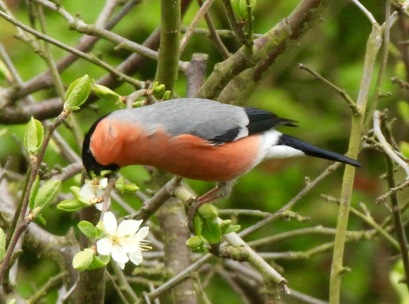Of Peregrines and Bullfinches- Those followers of the Sheffield Peregrines (search engine will give you the webcam) will know the chicks are hatching and look like lovely bundles of white fluff. The equally gorgeous Bullfinches that visit the garden every day are, however, chief culprits for our low level of Plum Blossom this year. Here they are
devouring our Plum blossoms and next doors Amelanchier blossom. The male is at its brightest at this time of year but like many birds this isn’t through moulting. Moulting happens later in the year but at this time of year the duller feather-tips wear off leaving the males in bright plumage for attracting a mate. Conditions: Cloud and some sun. Temperature: Max 11- Min 2c. Frost is predicted in some northern parts tonight!


































